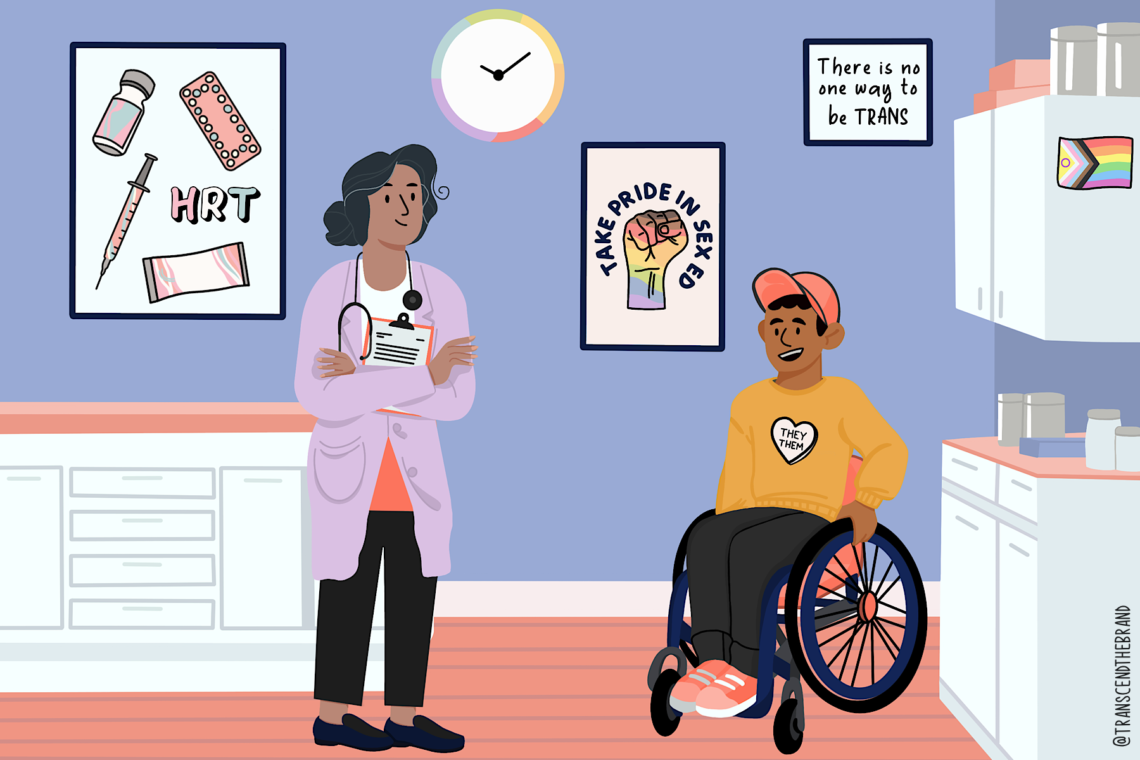Written by: Ella Vermeir (she/her) MA.
Edited by: Miles Llewellyn (they/them).
I was a front desk volunteer at a local sexual health clinic with a large number of trans* patients. I frequently spoke to trans* folks looking to book an appointment and when I informed them that our next available opening was two, three, or sometimes four weeks away, I often heard a version of: “If I have to wait, I’ll wait. This is the only place I feel [insert synonym for safe or comfortable] getting healthcare.” Hearing this sentiment with a concerning frequency got me thinking about what the experience of pursuing healthcare is like for a trans* person. As a cisgender woman, I have a privilege that shields me from the negative consequences of the implicit and explicit cissexism which exist within healthcare systems.
It was 2013 and I was startled by how little literature existed, especially Canadian content.
At the time, I was nearing the end of my undergraduate degree and had my sights set on medical school. I had always considered myself an ally of the 2SLBGTQIA+ community, but I realized that I knew very little about the struggles faced by the trans* population in relation to healthcare access and utilization. I started searching for literature on these experiences, and what healthcare providers (HCPs) could or should do to improve them. It was 2013 and I was startled by how little literature existed, especially Canadian content. The conspicuous underrepresentation in published research, coupled with the troubling personal anecdotes from trans* patients that I was often privy to, served as the impetus for me to pursue a master’s degree in Health Promotion. My thesis research allowed me the privilege of undertaking in-depth interviews with eight trans* Nova Scotians regarding their experiences with primary and emergency care. Two published articles targeted towards healthcare providers and policy makers with the intention of decreasing barriers to primary and emergency healthcare and increasing HCPs’ competence with trans* folks have been published from my thesis work (1, 2).
Throughout my conversations with the research participants, a number of suggestions for HCPs emerged, whether they were distinctly stated or inferred from participants’ accounts of their experiences. Now as a medical student, I reflect on these suggestions frequently– not only in relation to trans* patients but in the context of any marginalized population. A brief description of the participants’ suggestions for HCPs to improve their interactions with trans* patients will be provided in this article. For more detailed explanations see the two published articles (1, 2).
1. Know the basics and do not rely on patients to be your teacher.
Trans* patients frequently encountered HCPs who have very little baseline knowledge on trans* identities and health concerns (1, 2). The majority of participants in our study had encountered HCPs who were unsure of the meaning of “transgender” (1, 2), highlighting the extremely limited knowledge that some HCPs have. When seeing trans* patients, HCPs should acknowledge when they don’t know something and commit to learning it before they see the patient again (and actually follow through with this!). Participants appreciated when HCPs were upfront about their knowledge gaps and then showed improvement in their understanding over subsequent interactions (1, 2).
When HCPs are increasing their knowledge regarding trans* identities and health concerns, it is imperative that appropriate resources are used for this teaching. Participants in our study spoke about feeling as though they were expected to educate their HCP, with many referring to this as a burden (1, 2). The perceived expectation to teach HCPs about trans* topics is an unfair task to place on a patient unless they independently express a desire to help the HCP learn.When seeing trans* patients, HCPs should acknowledge when they don’t know something and commit to learning it before they see the patient again (and actually follow through with this!)
2. Ask: “How would you like to be addressed?” and use inclusive language.
It is critical that HCPs respect how a person wants to be referred to (name and pronouns) regardless of what is on their legal paperwork. Ask your patients what they like to go by and make note of it. If a HCP uses paper charts, it would be important to clearly write the patient’s name and pronouns in a location which would be visible to all staff who utilize the chart. For those who keep electronic records, adding an ‘alert’ that produces a pop-up with the patient’s name and pronouns each time the chart is accessed is an excellent way to make sure mistakes are not made. When a mistake is made in reference to someone’s gender, name, or pronouns, participants appreciated a brief apology and a correction of the mistake (1, 2). Participants found that drawn out apologies or in-depth excuses for why the mistake was made could be frustrating, triggering, and often pressures the patient into the emotionally laborious task of placating the professional (1, 2).
Furthermore, it is important to use inclusive language within all healthcare contexts. For example, calling a medical condition a “men’s or women’s health issue” can be very isolating and offensive for trans* folks as it categorizes people according to body parts and does not account for the diversity of bodies that exist (1, 2).
3. Ask yourself: “Why am I asking this question? Why am I performing this exam?”
When inquiring about one’s gender, transition, and health status related to their gender identity, it is crucial to keep questions relevant and to explain why you are asking for that information. Many participants felt as though HCPs were asking questions out of curiosity rather than to better inform the patient’s care (1, 2). One very clear example to illustrate this discrepancy was when a trans man was seeking healthcare for a sore throat. His HCP knew that he was in a relationship with a cisgender woman, yet the HCP asked, “how would a man have sex with you?” (1, 2). The patient felt as though this question was incredibly inappropriate and had no relevance to their health concern. Even when a question is relevant to a patient’s care, it must be asked appropriately with adequate sensitivity (1, 2).
The same suggestions also apply to physical examinations. Many participants discussed histories of trauma and feelings of discomfort surrounding physical exams (1, 2). It is important for HCPs to explain why an exam is indicated and to thoroughly explain what will happen. Continuous consent throughout the exam is also important such as, “I’m now going to do X now. Is that okay with you?” Patients should feel comfortable asking questions during the exam and should be draped appropriately so as to protect their privacy (1, 2). Previous research has indicated that trans women often avoid prostate and testicular exams and trans men often avoid mammograms and pelvic exams (3, 4). As these exams could potentially be lifesaving, it is critical that trans* patients feel comfortable pursuing these sorts of screening examinations.
4. Offer accommodations to make your patient more comfortable.
When appropriate, many participants were pleased that HCPs thought ‘outside of the box’ to offer accommodations that made them more comfortable. For example, a few trans men participants who were pursuing gynaecological care appreciated the opportunity to wait for their appointment in a private room rather than in the general waiting room. Another participant was relieved when they were told they did not need to change into a Johnny shirt to receive their x-ray if they weren’t comfortable doing so. Another participant who was receiving a transvaginal ultrasound was offered the option of inserting the probe themselves which helped to ease their anxiety about the examination. These are all examples of HCPs demonstrating a sensitivity to the concerns of patients. It goes without saying that such accommodations should be offered but not mandated. In other words, a trans* patient may accept the offer of sitting in a separate waiting room but being required to sit in a separate waiting room would be discriminatory (1, 2). Asking your patient, “is there anything I can do to make this more comfortable for you?” may elicit accommodations that are relatively easy to implement. Above all else, participants inferred that the best way to make trans* patients comfortable is to be supportive, kind, and respectful (1, 2).
5. Make or advocate for changes to your physical work environment.
Physical environment changes are often harder to implement quickly and usually require organizational and systemic involvement. However, it is important for HCPs to be aware of the physical factors that make trans* patients more comfortable in order to advocate for these changes in their workplaces. Participants discussed the importance of gender-neutral washrooms. These washrooms can be created by adding an ‘all genders’ sign to a single washroom, such as an accessible washroom, although this should be a temporary fix as it forces individuals to occupy a washroom that should be left available for patients with accessibility limitations. Some participants discussed how the physical layout of the environment can be challenging and worrisome for them. For example, if the reception desk is placed in the waiting room such that conversations are overheard, or if curtains are used to separate patients in the emergency department, individuals may be less likely to disclose personal information like their gender identity or name and pronouns.
Changes to the physical environment that are likely easier to implement are the inclusion of information targeted towards trans* individuals and the 2SLBGTQIA+ population, as well as indicators of the environment being a ‘safe space.’ These indications signify that the environment is knowledgeable about, and accepting of, trans* identities. It is critical that work is done to ensure that an environment is actually a safe space, such as providing training for all staff. Inclusive medical forms are another environmental aspect that can improve trans* patients’ healthcare experiences. Having space for individuals to write in the name they use and having a blank line with examples for patients to write in their gender identity (e.g., male, female, non-binary, trans man, trans woman, intersex, etc.) demonstrates inclusivity.
Of course, it is important to remember that a few members of a community do not speak for all members. However, I hope that these suggestions contribute to the life-long learning journey of HCPs and encourage HCPs to work towards providing compassionate and competent care to trans* patients. Advocating for learning opportunities, such as including more trans*-related content in our curriculums, will allow us all to better serve our trans* patients. I thank my research participants for being so candid with me and sharing their stories and experiences so that I can share them with you. Together, we can work towards creating equitable and safe healthcare spaces for all of our patients.
References:
1. Vermeir E, Jackson LA, Marshall EG. Barriers to primary and emergency healthcare for trans adults. Culture, Health & Sexuality. 2018 Feb;20(2):232-46.
2. Vermeir E, Jackson LA, Marshall EG. Improving healthcare providers’ interactions with trans patients: recommendations to promote cultural competence. 2018 Aug;14(1):11-8.
3. Baker K, Beagan B. Making assumptions, making space: An anthropological critique of cultural competency and its relevance to queer patients. Medical Anthropology Quarterly. 2014 Dec;28(4):578-98.
4. Williams M, Freeman P. Transgender health: Implications for aging and caregiving. Journal of Gay & Lesbian Social Services. 2008 Sep;18(3-4):93-108.



